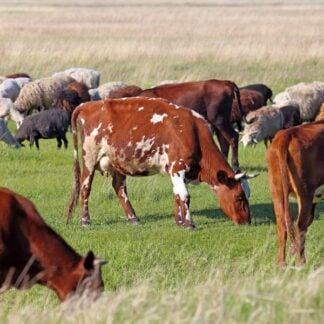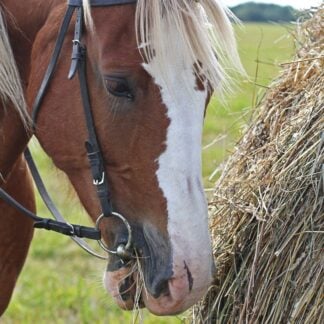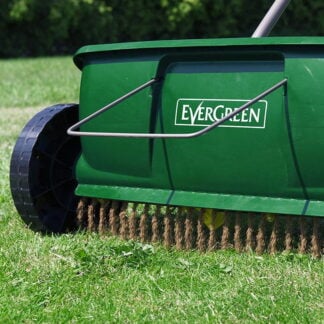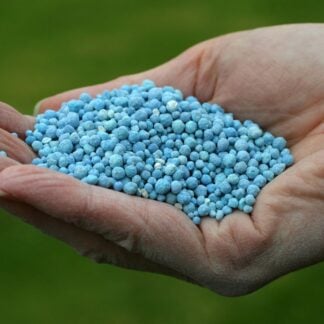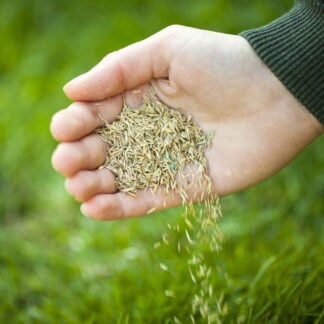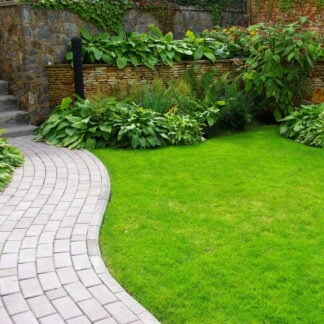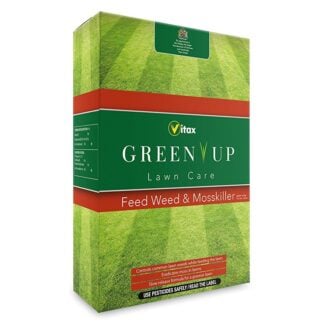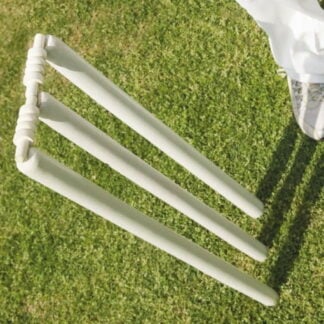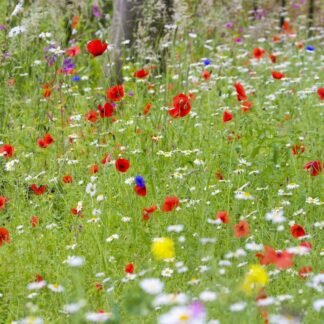Many garden lawns suffer from weeds and moss, controlling weeds and moss isn’t that difficult it done properly.
 It is possible to control weeds by using preventative and mechanical measures. The measures are dependant on the kind of weeds, the area, the lawn type etc. The right care i.e. the right cutting height and frequency, scarifying as well as aerating, will support the lawn grass and the sward density. This will therefore help to suppress any weeds.
It is possible to control weeds by using preventative and mechanical measures. The measures are dependant on the kind of weeds, the area, the lawn type etc. The right care i.e. the right cutting height and frequency, scarifying as well as aerating, will support the lawn grass and the sward density. This will therefore help to suppress any weeds.
A sward full of gaps will make it easier for the weeds to take hold. Weeds often establish if the grass is cut too low, if the sward is damaged by the wrong use of fertilisers or if damage occurs due to animals, weather, sports etc. If your maintenance measures are not successful, it is possible to control the weeds with chemicals.
Excess moisture, insufficient exposure, insufficient drying of the shaded areas, nutrient deficiencies and insufficient care all favour the development of moss. So firstly you must try to remove these favourable conditions. In addition, any moss that has developed should be treated in early spring with a moss killer. Once treated, the moss will change colour to brown/black and then die. Now it should be raked well. Where the lawn is full of gaps it should be overseeded so that new weeds or undesirable grass cannot take hold in the space left by the moss
Controlling Weeds & Moss For Older Lawns
In spite of good care, every lawn becomes older and gaps will appear. What can be done to improve things: seed for overseeding should be sown after cutting, along with the spring fertiliser application. The lawn is thereby rejuvenated every spring by new seed. Repair and rejuvenation are carried out as follows:
- Cut the lawn as tightly as possible. Work with a grass collector to remove all the clippings. If there are any left on the lawn, rake to leave the surface clean.
- Now scarify the surface to disturb the soil and remove the thatch and plant leftovers. Afterwards, clean the surface thoroughly so that the seed will have enough light and air.
- Lawn seeds grass seed should be scattered at 30-35g/ square metre and rolled. To speed up germination and to prevent drying out, watering is necessary.
-

Agricultural Grasses (37)
-

Cutting & Grazing (4)
-

Environmental Mixes (5)
-

Equine Mixes (8)
-

Equipment (10)
-

Fertilisers (11)
-

Game Birds & Poultry Pens (2)
-
%22%20transform%3D%22translate(.6%20.6)%20scale(1.26563)%22%20fill-opacity%3D%22.5%22%3E%3Cellipse%20fill%3D%22%23cc7a5f%22%20rx%3D%221%22%20ry%3D%221%22%20transform%3D%22rotate(-23.2%20406%20-83.5)%20scale(106.46892%2057.74383)%22%2F%3E%3Cellipse%20fill%3D%22%235a5b8c%22%20rx%3D%221%22%20ry%3D%221%22%20transform%3D%22matrix(29.10996%20-26.21073%2030.93075%2034.35208%20143.3%2073.2)%22%2F%3E%3Cellipse%20fill%3D%22%2379460d%22%20rx%3D%221%22%20ry%3D%221%22%20transform%3D%22matrix(-74.24038%20-18.27281%209.83273%20-39.94928%20208.5%20181.7)%22%2F%3E%3Cellipse%20fill%3D%22%2342610c%22%20rx%3D%221%22%20ry%3D%221%22%20transform%3D%22matrix(-31.89003%2017.53503%20-16.73739%20-30.43941%209.8%2063.3)%22%2F%3E%3Cellipse%20fill%3D%22%238b2d47%22%20cx%3D%2256%22%20cy%3D%22240%22%20rx%3D%2270%22%20ry%3D%2226%22%2F%3E%3C%2Fg%3E%3C%2Fsvg%3E)
Game Cover Crops (20)
-

Garden Seeds (20)
-

Grass Seed (23)
-
%22%20transform%3D%22translate(.6%20.6)%20scale(1.26563)%22%20fill-opacity%3D%22.5%22%3E%3Cellipse%20fill%3D%22%23a6a3ba%22%20rx%3D%221%22%20ry%3D%221%22%20transform%3D%22matrix(-26.84416%2073.92381%20-57.08844%20-20.73068%20120.5%20118)%22%2F%3E%3Cellipse%20fill%3D%22%233f4912%22%20cx%3D%2245%22%20cy%3D%22241%22%20rx%3D%22255%22%20ry%3D%2239%22%2F%3E%3Cellipse%20fill%3D%22%23425000%22%20rx%3D%221%22%20ry%3D%221%22%20transform%3D%22matrix(-27.18905%20.88046%20-3.8161%20-117.8434%2016.9%20177.6)%22%2F%3E%3Cellipse%20fill%3D%22%23b8c76f%22%20rx%3D%221%22%20ry%3D%221%22%20transform%3D%22rotate(125%2099.6%2067)%20scale(71.21693%2038.88793)%22%2F%3E%3Cellipse%20fill%3D%22%23726d8d%22%20cx%3D%22117%22%20cy%3D%22187%22%20rx%3D%2279%22%20ry%3D%2242%22%2F%3E%3C%2Fg%3E%3C%2Fsvg%3E)
Grazing Mixes With Clover (5)
-
%22%20transform%3D%22translate(.6%20.6)%20scale(1.26563)%22%20fill-opacity%3D%22.5%22%3E%3Cellipse%20fill%3D%22%23d5cff9%22%20rx%3D%221%22%20ry%3D%221%22%20transform%3D%22matrix(2.7787%2048.19147%20-226.87678%2013.08163%20123%2032.7)%22%2F%3E%3Cellipse%20fill%3D%22%23304000%22%20rx%3D%221%22%20ry%3D%221%22%20transform%3D%22matrix(-243.33128%2076.2554%20-22.22466%20-70.91898%20159.7%20212.2)%22%2F%3E%3Cellipse%20fill%3D%22%232b3600%22%20cx%3D%22210%22%20cy%3D%22235%22%20rx%3D%2267%22%20ry%3D%2267%22%2F%3E%3Cellipse%20fill%3D%22%237b822d%22%20cx%3D%2267%22%20cy%3D%22144%22%20rx%3D%22174%22%20ry%3D%2250%22%2F%3E%3Cellipse%20fill%3D%22%238f8d9a%22%20rx%3D%221%22%20ry%3D%221%22%20transform%3D%22matrix(128.3648%202.4825%20-.63068%2032.61098%20186.4%2069)%22%2F%3E%3C%2Fg%3E%3C%2Fsvg%3E)
Grazing Mixes Without Clover (9)
-

Green Manure Crops (23)
-
%22%20transform%3D%22translate(.6%20.6)%20scale(1.26563)%22%20fill-opacity%3D%22.5%22%3E%3Cellipse%20fill%3D%22%234f5a15%22%20cx%3D%2274%22%20cy%3D%22224%22%20rx%3D%2282%22%20ry%3D%2282%22%2F%3E%3Cellipse%20fill%3D%22%23313a02%22%20rx%3D%221%22%20ry%3D%221%22%20transform%3D%22rotate(-78.2%20258.4%20-31.6)%20scale(117.38926%2031.00042)%22%2F%3E%3Cellipse%20fill%3D%22%23b5c07c%22%20rx%3D%221%22%20ry%3D%221%22%20transform%3D%22matrix(-249.42764%2053.01748%20-14.34474%20-67.4867%2087%2046.9)%22%2F%3E%3Cellipse%20fill%3D%22%23737e3a%22%20rx%3D%221%22%20ry%3D%221%22%20transform%3D%22matrix(49.99886%20-29.21697%2033.56314%2057.43642%20140.8%20119.8)%22%2F%3E%3Cellipse%20fill%3D%22%2398a35f%22%20rx%3D%221%22%20ry%3D%221%22%20transform%3D%22matrix(-38.14139%208.1768%20-9.2251%20-43.03125%2058.3%20157.6)%22%2F%3E%3C%2Fg%3E%3C%2Fsvg%3E)
Green Manures (4)
-
%22%20transform%3D%22translate(.6%20.6)%20scale(1.26563)%22%20fill-opacity%3D%22.5%22%3E%3Cellipse%20fill%3D%22%233b4800%22%20rx%3D%221%22%20ry%3D%221%22%20transform%3D%22matrix(-.316%20-60.35224%20157.19275%20-.82307%2024.5%20195.7)%22%2F%3E%3Cellipse%20fill%3D%22%23e1def4%22%20rx%3D%221%22%20ry%3D%221%22%20transform%3D%22matrix(-16.96975%2071.23156%20-239.2177%20-56.9897%20132.2%2057)%22%2F%3E%3Cellipse%20fill%3D%22%239786ff%22%20cx%3D%22228%22%20cy%3D%2213%22%20rx%3D%2252%22%20ry%3D%2238%22%2F%3E%3Cellipse%20fill%3D%22%23546304%22%20rx%3D%221%22%20ry%3D%221%22%20transform%3D%22matrix(-2.61844%2034.83143%20-90.5235%20-6.80507%2032%20186.9)%22%2F%3E%3Cellipse%20fill%3D%22%2382808b%22%20rx%3D%221%22%20ry%3D%221%22%20transform%3D%22matrix(-7.97125%20-19.41125%20105.15469%20-43.18187%20126.7%20231.1)%22%2F%3E%3C%2Fg%3E%3C%2Fsvg%3E)
Landscape Seeds (3)
-
%22%20transform%3D%22translate(.6%20.6)%20scale(1.26563)%22%20fill-opacity%3D%22.5%22%3E%3Cellipse%20fill%3D%22%233a5400%22%20rx%3D%221%22%20ry%3D%221%22%20transform%3D%22matrix(3.34972%20106.07826%20-64.77578%202.04548%20119.7%20125)%22%2F%3E%3Cellipse%20fill%3D%22%23fff%22%20cx%3D%22229%22%20cy%3D%22126%22%20rx%3D%2235%22%20ry%3D%22255%22%2F%3E%3Cellipse%20fill%3D%22%23fff%22%20cx%3D%2220%22%20cy%3D%2268%22%20rx%3D%2230%22%20ry%3D%22255%22%2F%3E%3Cellipse%20fill%3D%22%23285826%22%20rx%3D%221%22%20ry%3D%221%22%20transform%3D%22matrix(10.59821%20-43.14272%2043.93623%2010.79314%20118.6%20114.6)%22%2F%3E%3Cellipse%20fill%3D%22%23fff%22%20rx%3D%221%22%20ry%3D%221%22%20transform%3D%22matrix(-4.00537%20-254.96854%2027.93346%20-.43881%20236%20153)%22%2F%3E%3C%2Fg%3E%3C%2Fsvg%3E)
Lawn Feed - Weed & Moss Killer (1)
-
%22%20transform%3D%22translate(.6%20.6)%20scale(1.26563)%22%20fill-opacity%3D%22.5%22%3E%3Cellipse%20fill%3D%22%23a7b86c%22%20rx%3D%221%22%20ry%3D%221%22%20transform%3D%22matrix(248.57146%20-56.89667%2011.057%2048.30604%20172%20225)%22%2F%3E%3Cellipse%20fill%3D%22%232c2b4b%22%20rx%3D%221%22%20ry%3D%221%22%20transform%3D%22matrix(-40.39834%203.1904%20-8.82528%20-111.75011%2072.5%20117.5)%22%2F%3E%3Cellipse%20fill%3D%22%23794d04%22%20rx%3D%221%22%20ry%3D%221%22%20transform%3D%22rotate(152.9%2089.7%2029.9)%20scale(88.84689%2065.12872)%22%2F%3E%3Cellipse%20fill%3D%22%231b2a34%22%20rx%3D%221%22%20ry%3D%221%22%20transform%3D%22matrix(-22.18365%209.27962%20-12.95418%20-30.96795%20189.6%2082)%22%2F%3E%3Cellipse%20fill%3D%22%23b5c370%22%20cx%3D%22202%22%20cy%3D%22240%22%20rx%3D%2273%22%20ry%3D%2223%22%2F%3E%3C%2Fg%3E%3C%2Fsvg%3E)
Renovation Mixes (4)
-

Silage Mixes (6)
-

Sport Seed Mixtures (5)
-

Wildflowers (18)

